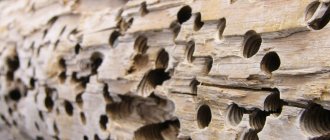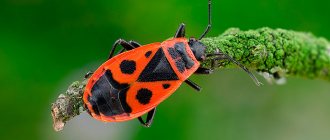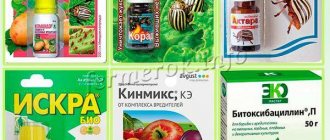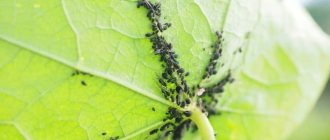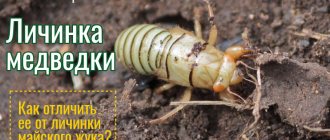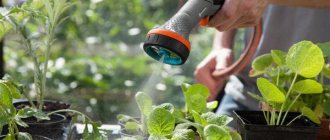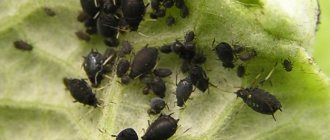Home / Pests and diseases
Back
Published: 06/09/2019
0
Rate this post
There are plenty of insects in nature that destroy plants. One such pest is the peach aphid. Having chosen a tree, it will multiply exponentially and will not leave until it has sucked all the tasty juice from its leaves and destroyed the crop.
There are several types of aphids on peach: large peach, blood, gray, black and green. Whatever it is, the result of its activity will be disastrous. How to treat the garden in order to get rid of the invasion of the voracious insect, we will consider in this article.
- 1 Causes and signs of appearance
- 2 Which processing method to choose
- 3 Chemicals
- 4 Traditional methods
- 5 Prevention
Blood aphid
This type of aphid is very dangerous, as it literally sucks all the juice out of the peach tree. Aphids can be recognized by certain features. For example, a large number of insects on the leaves, especially on the inside. When you press on an insect, a red liquid is released from it, which is why this aphid is called bloody. Aphids have fluff that is quite thick. Experts recommend examining peach trees more often in order to cure the tree from infection in time, otherwise, if the tree is not cured, it will begin to wither, become covered with ulcers and reduce the amount of its harvest.
Morphologically related species
In terms of external characteristics (morphology), the Elm-pear aphid (Eriosoma lanuginosum) is close to the described species. The migratory form lives on the roots of pear, quince, and apple trees. In September, the stripers move to the elm. It differs from the described species in its ability to form large, 6–10 cm in diameter, galls on the leaves. Inside these formations, the founder gives birth to larvae, which subsequently develop into winged forms.[7]
We suggest you familiarize yourself with Fighting tree fungus
The color of the integument is whitish or reddish-yellow. In contrast to the described species, in adults (with the exception of autumn alates migrating to elm), the third antennal segment is shorter than the fourth and fifth joints combined; tibia of hind legs 1.2 times longer than femurs; the tarsi in adults and in older larvae are two-segmented; in the younger ones they are single-segmented. The claws on the tarsi of adult insects are almost one and a half times longer than their first segment.[3]
In addition to the above-described species, the yellow root aphid (Eriosoma flavum) and the pear aphid (Eriosoma pyricola), which are also similar in structure to the Blood aphid (Eriosoma lanigerum), are more common than others.
Green aphid
This type of aphid is a carrier of a huge variety of viruses. This species poses a great danger to a young tree or seedling; it sucks the sap from the tree and this can lead to both death and slight drying out if the pest is stopped in time. A shoot that has been damaged freezes in cold weather, and a fungus also appears on it. You can recognize such aphids by their leaves; they begin to curl and become lighter, and the trees also begin to shed their buds.
Maliciousness
Blood aphids primarily colonize young shoots at the base of the buds, on the petioles of leaves, and often on the stalks. In places where the insect feeds, nodular thickenings are formed, consisting of tissue of a loose structure and covered with a delicate bark. The nodules grow and crack, forming deep ulcers. Putrefactive bacteria penetrate into the ulcers, leading to the death of the plant. Mature trees infected with blood aphids stop bearing fruit after two to three years and die.
We suggest you familiarize yourself with Cuttings of Petunias, or How to Propagate Beauty
The economic threshold of harmfulness occurs when 25% of the leaves are colonized.
Black aphid
Black aphids can be recognized by their location; they gather in flocks on leaves, inside the plates. Most often, it settles and infects young trees that have not yet formed. When there are a large number of insects, liquid begins to appear on the tree, it is very sticky, since there are saccharides there, and it is secreted by insects. The shoots and leaves begin to curl upward, the buds stop opening and the harvest becomes minimal. This type of aphid is strongly attracted to fungal diseases. Such aphids can easily overwinter in the bark of a tree, and when warm days begin, they can infect the tree again. A flock of black aphids mainly consists of females, so getting rid of such aphids is very difficult, because they give birth to offspring every time.
Set of preventive measures
To protect the tree and crop from aphid attacks, it is necessary to carry out timely prevention:
- In autumn, clear the tree trunk area of leaves, weeds and plant debris.
- Dig up the soil thoroughly.
- In the spring before sap flow and in the fall after leaf fall, treat the tree with Bordeaux mixture.
- A month before the onset of frost, whitewash the trunk. Before whitewashing, clean the trunk of lichen and moss with a wire brush or wooden scraper. Treat the damaged bark with iron sulfate and cover it with garden pitch.
- Perform sanitary pruning in a timely manner.
Great peach aphid
This species is the most common and most often affects the peach tree. Infection of a tree occurs in the summer, usually in July or August, since it is during this period that aphids reproduce at the highest speed, forming swarms that can be easily noticed. Aphids are located inside the leaf; they secrete sugar and attract ants. If you do not eliminate the aphids, they will produce about 9 generations. Aphid eggs, which were laid in the autumn, quietly overwinter in the tree bark, and in the spring they begin to eat the tree from the inside, sucking out the necessary substances. This leads to the falling of leaves and the death of the tree itself.
Where and why does it appear?
Aphids overwinter in the ground or in last year's autumn leaves. If aphids damaged peppers last gardening season, you should not plant them in the same place this year, as there is a high risk of infecting new plants. Insect eggs overwinter in leaves or under tree bark.
As the weather gets warmer, females are born first, which will then give rise to a whole colony of aphids. Ants play a major role in the appearance of aphids. Since not all aphids have wings to move, ants help them. In return they receive food - honeydew.
Important! This symbiosis allows some to be constantly full, while others expand their habitat.
The main reason for the appearance of aphids on pepper seedlings is that young shoots are very attractive to pests, they are juicy and rich in nutritional components.
How to recognize aphids
In order to begin treatment, you need to find out what kind of pest is on the tree. Aphids have signs that make them easy to recognize:
1. A mucous liquid appears on the buds, leaves, and flowers.
2. Up shoots begin to die.
3. Leaves become curled, limp and dry, this is due to insects feeding on tree sap.
4. The tree stops developing.
5. The harvest becomes minimal or disappears completely.
Note: When aphids appear on a peach tree, it must be treated immediately, and under no circumstances should you hesitate, as aphids spread very quickly.
The main reasons for the appearance
Large peach aphids can also be found on almonds, plums, apricots, and cherry plums. Aphid development occurs in early June–July. Flying from tree to tree, they form a large number of colonies. The active phase of insect development begins in late June - early August, when aphids cling to large branches.
Peach is also susceptible to green aphids, which also feed on vegetables and flower crops. Often aphids appear due to infestation with weeds, which are optimal conditions for the development of the pest. For aphids, the weed is considered an intermediate plant, a source of food.
The spread of colonies can be prevented by timely weeding and weed removal. It is important to remove loose bark from the tree trunk and branches.
Fighting aphids
Treating the peach tree will ensure its protection from various types of aphids and this should be done 3 times during the whole season. The first treatment is carried out before the buds ripen, the second treatment is carried out when the first leaves appear on the tree and the third treatment is carried out before the buds open.
Treatment should be carried out at an early stage of the disease, since this type of treatment will prevent insects from reproducing. You can get rid of aphids in different ways: mechanical, chemical and folk.
The method using chemicals must be used quite carefully, since if not carefully, the tree itself may be damaged. Experts recommend using a mechanical or traditional method.
Spraying schedule
The quality of fruiting of peach plantations is affected by care. The spraying schedule involves several applications per season.
Spring prevention
In the spring, several sprayings will be required. The tree is treated for the first time before buds open. This is necessary to destroy aphids overwintering under the bark of the trunk and branches. Spraying is carried out using fungicides from copper sulfate and Bordeaux mixture. A common option is to use diesel fuel - it forms an oily film on the peach that blocks oxygen for the aphids.
It is important to spray the tree to avoid curling. The infection begins to spread as the tree begins to grow and develop. Fungal pathogens live in the bud scales, which is why the leaves, as they grow, acquire a reddish tint, begin to curl, and fall off.
It is necessary to combat pathology before the appearance of foliage, before the formation of buds. The trunk, branches, and green cone are subject to spraying. Treatment is carried out with drugs like Delana or Horus.
Next, you need to spray the pink buds - this will strengthen the plant’s immune system, prevent powdery mildew, scab, and moniliosis. The procedure is carried out using Bordeaux mixture or Topsin.
The final spring sprinkling of the peach is carried out after it has bloomed. The procedure is carried out with ordinary urea - it will destroy aphids and feed the tree.
Summer work
Summer sprinkling is carried out using urea - the most popular modern fungicide. The effect of the drug is similar to acid - it burns all harmful insects.
When diluting the solution, you must strictly adhere to the dosage so as not to burn the peach.
Young trees are sprinkled carefully; it is recommended to use traditional methods rather than chemicals. Sprinkling the peach with garlic, tobacco, onion, and lavender tincture will be effective.
Autumn time
The purpose of autumn sprinkling is to destroy the causative fungus. In the autumn, with high air humidity, active proliferation of fungi occurs. The treatment is carried out using copper sulfate and Bordeaux mixture.
Mechanical method
There are a huge number of mechanical methods of treatment, but the most effective are:
1. Use of water.
With this method, insects are washed off with water. First you need to clear the circle of the trunk from weeds or grass, and clean the trunk and branches. Afterwards, you need to wash off the insects with a powerful jet, directing them to the leaves.
2. Planting plants with a specific smell next to the peach.
All types of aphids do not respond well to strong odors, so plants with a strong odor will help in getting rid of aphids. This method is also recommended for prevention. Aromatic plants include mint, calendula and other plants. You can also plant dill, which will attract ladybugs, and they, in turn, will get rid of aphids on the tree, as well as get rid of other insects. Leaves that are already affected should be cut off and burned.
A belt of resin will also help protect the plant from insects. To do this, 40 days before the cold weather sets in, the trunk must be sprinkled with ash and poured with hot water. The ash that has been dissolved begins to penetrate the bark and root system of the tree, after oxidation it repels insects. Boiling water also kills insects. If the number of aphids is huge, then the mechanical method may not help, then you need to try a method using chemicals. But before using this method, you need to understand that during the harvest period, under no circumstances should you carry out processing.
Prevention
In the spring, the larvae, which have overwintered in the soil and on the bark of trees, will emerge from their shelters and, having grown stronger, will begin to rapidly reproduce. Therefore, even before the buds on the peach swell, you need to take care of comprehensive pest control. The main thing is not to give aphids the opportunity to multiply and destroy the plantings when there are no mass colonies yet. It is recommended to spray the peach with fungicides during bud break, as well as after flowering. When treating a garden with pesticides, it is strongly recommended not to rush, but to conduct a test. Young trees are susceptible to the components of the drugs and may die. In order not to destroy the plant, on the first day they treat one or two branches by spraying the drug on them, and after a day they look to see if there are any changes. If everything is good, then you can process all the peaches.
It’s easier not to solve any problem, but to prevent its occurrence. To prevent aphids from infecting peaches, prevention is needed:
- We regularly check the garden for the presence of ants. They breed aphids and carefully protect them. Anthills should be destroyed or moved to the forest.
- After winter, trees need to be whitened using lime.
- Dry and diseased branches found must be cut down.
- Plant repellent plants (lavender, mint, garlic) and flowers that attract beneficial insects near the trunk.
- Spray peaches as a preventative measure with infusions made from herbs and flowers.
- Bring beneficial insects (ladybugs, lacewings) to the site.
If you carry out preventative measures and monitor the area, you can protect the trees and plants of the entire garden from harmful insects.
Rate this post
Chemical method
This method is used in the spring, when the buds are still “sleeping,” during the flowering period and before harvesting. With this method, insecticides are used. This drug penetrates the bark and leaves of the tree and deprives insects of movement, so they die.
Note: Insecticides should be used only according to the instructions. After all, improper processing can damage the tree. Proper treatment allows you to see results within 5 days of using the chemicals. With this method, you can use the following drugs: Aktara, Topaz, Topsin, Karbofos.
Dangerous peach pests detected
It may seem that this tree has very few enemies. If they appear, they quickly disappear. In fact, this happens when experienced gardeners take care of the tree. To protect your favorite fruit from insatiable enemies, you should get to know them better. Peach pests attack different elements of the plant:
- sheet plates:
- stems;
- fruit.
As a result, the development of the peach slows down, the harvest is lost and leads to death. The most reliable way to save a tree is to detect pests and tirelessly fight them
But first it is important to know the enemy by sight
Disguised roommate - scale insect
At first glance, the insect looks quite cute. Its body is covered with a dense shell, which seems to have been smeared with wax. From the outside it resembles a shield (hence the name of the insect). There are a huge number of species in nature. They differ from each other in color, shape, size and food preferences. These peach pests settle on the tree bark. They suck moisture from it, lay eggs and even hibernate. They grow up to 7 mm. Some insect species are viviparous. After hatching, the larvae are in active motion until they find a secluded place. They attach themselves to shoots, foliage and trunks with their proboscis, then secrete wax, which later becomes a protective shield.
When an insect attacks a tree, special signs of its presence appear:
On this topic:
BACK
FORWARD
1 of 75
- leaf blades begin to wither;
- young shoots curl;
- the bark becomes loose;
- the fruits are strewn with red dots.
How to deal with scale insects on peach in order to protect the tree from damage and reap a valuable harvest? There are several ways:
- Manually. If the tree is small, insects can simply be collected from their places of “dislocation” and destroyed.
- Agricultural technology. Removing damaged shoots, thinning the tree crown.
- Folk method. Spraying peach with tincture of tobacco leaves.
- The use of chemicals to treat the plant in mid-spring and again in August.
You can prepare the tincture as follows: dilute 400 g of tobacco in 10 liters of water and leave for 24 hours. Then boil the liquid for 2 hours and add laundry soap (about 50 g). Dilute the finished product with water (10 l).
Invisible sucker - harmful aphid
When people say: “I’ve already been drained of all the juice,” they have no idea how trees feel in such cases. The appearance of peach aphids immediately affects the plant:
On this topic:
BACK
FORWARD
1 of 39
- young shoots begin to wither;
- leaves dry out and fall off prematurely;
- dry branches appear;
- the plant is susceptible to disease.
Insects often settle in the lower part of the leaf plate, on buds (during the flowering period), on the tops of young shoots
Their presence is indicated by the appearance of a sticky liquid, which attracts the attention of the ant colony. As a result, the tree suffers from an attack by an entire army of peach pests, and fighting them is a sure way to salvation for the fruit.
To achieve this, drastic measures are taken:
- removal of root shoots;
- weeding the soil near the trunk;
- cleaning areas where aphids accumulate manually or using a hose with water;
- attracting “allies” to the cause: wasps, ladybugs, hover flies;
- growing repellent plants (nettle, herbs, onions);
- spraying with tinctures of garlic, dandelions and onion peels;
- pre-treatment of peach in the spring against pests with chemicals.
If you apply the listed methods of combating aphids in time, then in the summer the tree will bear a generous harvest.
A cute pest - the eastern codling moth
A small butterfly with a dark body and gray-brown wings appears in the garden during the flowering of peach trees. The insect is especially active in the mornings and late evenings. It lays hundreds of eggs on the tops of young stems, buds and stalks. When the eastern codling moth larvae develop, they need the food they get from the peach. As a result, the tree begins to hurt. Gum and cracks immediately appear on the young shoots, which can lead to the death of the plant.
To combat insects, gardeners use the following methods:
- remove damaged leaves, bark, shoots from the tree;
- loosen the soil around the peach trunk;
- attach pieces of cloth soaked in chlorophos to the branches.
But to get a final victory against pests, it is necessary to take drastic measures.
Folk way
Most often, folk methods are used to combat aphids. Gardeners prefer this method, as it is harmless and does not harm the tree. Moreover, such methods can be used at any period of plant development.
The most popular are these methods:
1. Infusion of onions and laundry soap.
For this infusion you will need onion peels, laundry soap and water. Onion peels and water are mixed in a ratio of 20% to 80% and set to cook for 30-35 minutes. Then the solution is covered and placed in a warm and dark place to infuse for 4-7 days. After a while, rub laundry soap into it and stir. This infusion should be sprayed on the leaves.
2. Garlic infusion.
To prepare the infusion, you need to take 500 grams of garlic and 1.5 liters of warm water. The ingredients are mixed and infused for a day. Afterwards, laundry soap is added, which must be rubbed in advance. This solution must be diluted with 6 liters of clean water.
3. Pepper infusion.
For this infusion you will need various spices, you need to take cinnamon, soda, pepper, mustard and ash. The components are filled with water and laundry soap is added to them. Everything is thoroughly mixed. This solution should be used only 3 times with a break of a week.
4. Tobacco infusion.
Add 300 grams of tobacco product to 4 liters of water and leave for 72 hours. After this, laundry soap is added to it. The solution is ready.
5. Using ammonia.
25 milliliters of ammonia and 15 grams of washing powder are diluted in 4 liters of water. All ingredients are mixed until bubbles appear. The solution is used only 2 times with a break of a week.
6. Orange infusion.
We will need orange peels, which must be filled with 1 liter of water and left for 72 hours. Then the solution is cleared of crusts and the infected areas are sprayed with it.
codling moths
Codling moths pose a serious threat to young shoots and to the harvest (if the fight against these pests of peach is late, then all the fruits may die). Most often, peaches fall prey to the oriental and plum moths.
Eastern moth
The damage caused by the oriental codling moth is not limited to fruit damage. Caterpillars devour young shoots and carry fungi (including an ascomycete that causes moniliosis). The first signs of pests are:
- gum on young shoots, longitudinal cracks, their lethargy and death;
- wormholes on the surface of peaches.
Did you know? The Eastern codling moth is a lepidopteran butterfly (15 mm in length). The female is larger than the male. The wings are gray-brown, the body is dark. The homeland of butterflies is the countries of East Asia. The flight of butterflies lasts a month during the peach blossom period. More active in the evenings and early mornings. Eggs (from 100 to 200) are laid on the tips of shoots, buds (females of the first generation), sepals and stalks (females of the second generation). One generation lives from 24 to 40 days. Up to 4 generations can pass during a season, overlapping one another. They wait out the winter in cracks in the bark, under fallen leaves.
When fighting the eastern codling moth, agrotechnical, natural and chemical means are used:
agrotechnical measures are preventive and health-improving measures - in the evening, dead bark is cleared off, dead leaves and carrion are removed, damaged shoots are pruned, the earth around the tree is dug up (in spring and summer - loosened) in the fall. They also use traps - glue traps with pheromones for males (the effectiveness of this technique is low), belts on the trunk made of fabric impregnated (one percent chlorophos);
natural (biological) - using hymenoptera trichogramma (equiped ichneumonids that parasitize on codling moth eggs) - during the period of egg laying by codling moths;
chemicals are used against each generation (including after harvest). A strong remedy against the oriental codling moth is benzophosphate (per 10 l - 60 g) - sprayed three times (the interval between treatments is 15 days) after flowering. They also use “Chlorofos” (per 10 l – 20 g), 25% “Rovikurt” (per 10 l – 10 g), 10% “Karbofos” (per 10 l – 60 g), etc. The usual consumption is up to 10 l mixture for an adult tree and 2 liters for a young tree.
Important! During the flowering period of peach trees, treating with insecticides is strictly prohibited. Other crops in the garden should be covered with film during the period when peaches are treated with insecticides.
Plum moth
The larvae of the plum moth infect peach fruits: they eat away the pulp and core of the stone, disrupt the vessels from the petiole (the flow of juices stops), the fruit begins to wither, ripen prematurely and falls.
The first sign of the presence of the plum moth is the massive falling off of green peaches with wormholes, as well as the appearance of lumps of cobwebs on the fruits and leaves.
Did you know? The plum moth resembles the eastern moth in appearance and is larger in size (up to 2 cm). The flight of butterflies occurs at the end of May - beginning of June. The butterfly lives from 4 to 15 days and manages to sow up to 50 eggs on fruit. The caterpillars independently gnaw through the skin of the peach and penetrate into the fruit. During the season, two generations of moths pass through. Caterpillars overwinter in dense cocoons made of cobwebs in crevices of the bark, in the soil under the tree.
Protection of peach from these pests by agrotechnical and natural means is similar to that applied to the eastern codling moth. With a small number of pests, it is advisable to use the biological product “Bitoxibacillin” against each generation (40-80 g per 10 liters).
The use of chemicals has its own specifics:
- treatment is carried out until the caterpillars appear (when lumps of cobwebs appear) - “Intavir” (one tablet per 10 l);
- against second generation caterpillars - “Fufanon”, “Sumition”, “Novaktion” (but not less than 30 days before harvest).
